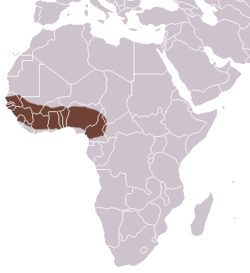| Hausa genet | |
|---|---|
 | |
| Scientific classification | |
| Kingdom: | Animalia |
| Phylum: | Chordata |
| Class: | Mammalia |
| Order: | Carnivora |
| Suborder: | Feliformia |
| Family: | Viverridae |
| Genus: | Genetta |
| Species: | G. thierryi |
| Binomial name | |
| Genetta thierryi Matschie, 1902 | |
 | |
| Hausa genet range | |
The Hausa genet (Genetta thierryi) is a genet species native to West African savannas. It is listed as Least Concern on the IUCN Red List. [1]
Contents
Hausa genets have been sighted in Senegal's wooded steppes, in moist woodlands in Guinea-Bissau, and in rainforest in Sierra Leone, Ghana and Ivory Coast. [2]
